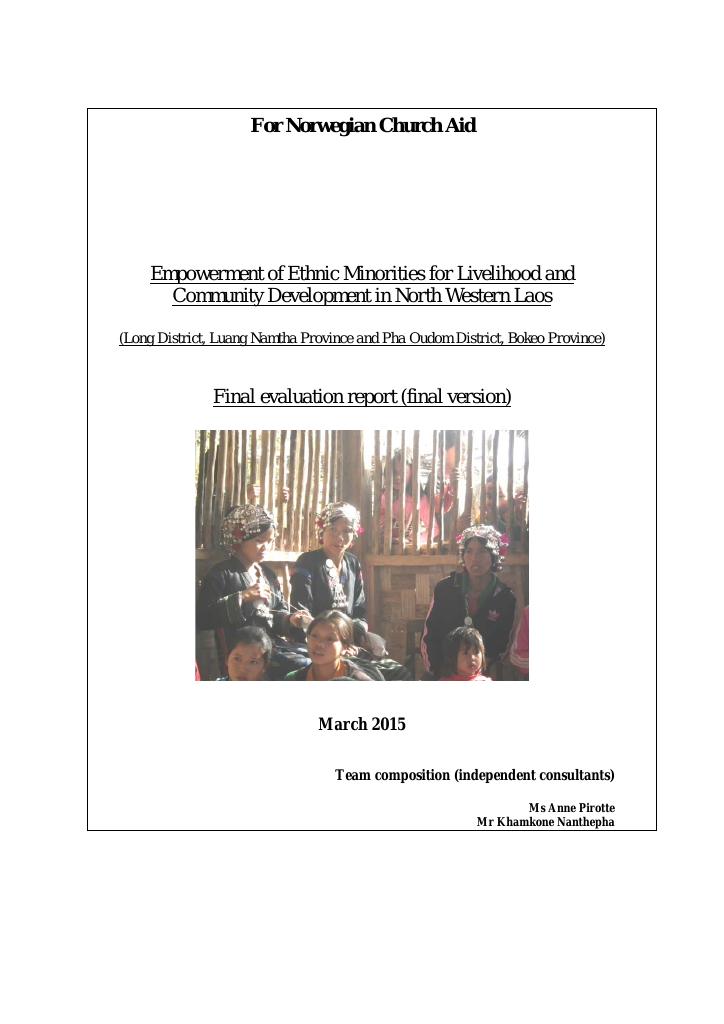Evaluering
Empowerment of Ethnic Minorities for Livelihood and Community Development in North Western Laos
Background: Since the1st February 2008, NCA has been implementing a livelihood and community development intervention in the areas of Long (Luang Namtha province) and Pha Oudom (Bokeo province). 2011 was used as a gap year for the development of the last phase of the project (2012-2014) aimed at granting sustainability after ending support to the current project villages. From the period of February 2008 to January 2010, the livelihood project was implemented in 33 villages. 26 of these villages are located in Long district and 7 of them in Pha Oudom district. The last phase project (2012-2014) was implemented in 21 and 6 villages of Long and Pha Oudom districts respectively. Overall, this livelihood intervention aims at improving the quality of life of the target population while preserving the environment and ensuring a sustainable use of natural resources. Purpose/objective: The objective of the evaluation was to get an independent and external assessment of achievements from the 6 year project supported by KCF from 2008 to 2014. In particular, the objective of the evaluation was to examine to what extent the project has brought meaningful results for the rights holders related to their needs and challenges. The evaluation also sought to provide practical recommendations for the expansion or future interventions in the area of livelihoods by NCA. In sum, the evaluation was meant to serve as an assessment of the effectiveness, relevance, efficiency, impact and sustainability of the project. Methodology: The consultant team for the external project evaluation has gathered information by doing desk review of the project documents and individual interviews and focus group discussions of different stakeholdera. The village sampling method was discussed and agreed with NCA and is designed to be as representative of the villages as possible. The selected villages are representative of implemented activities, while covering contrasted situations corresponding to different realities, challenges and opportunities. Key findings: Based on a qualitative assessment of the 5 evaluation criteria, the project has been found satisfactory, with a special mention for gender mainstreaming and women’s empowerment. Quantitative indicators related to rice and cash crops indicate the boom of cash crops in terms of area planted and production: job's tears in POD and various crops in Long (job's tears, cassava, vegetables, sesame and oil bean), while maize production decreased very much. Upland rice productivity increased by 8 and 11% in Long and POD respectively, while paddy rice productivity increased by 26% (in Long only and on a limited area). Thanks to the cash crops, HH increased their income much: +83% in Long and +548% in POD. Recommendations: Market economy: promotion of cash crops for consumption; discussion with farmers on the risk of specialization and resilience to changes. Sustainable land use at risk: promote mixed cropping (as opposed to industrial cropping). Substitution to opium: Investigate opportunities of high value for weight products. Nutrition and agriculture production strategies: promotion of existing agricultural production for self-consumption. Marketing through contract farming: sharpen farmers’ negotiation skills and give them the opportunity to practice; Facilitate other opportunities for marketing; Self-seeds supply. Village leaders: Try not to overload the village head if they are other potential leaders in the village. RBA: Opportunity to increase transparency of contract farming process. Groups & Community Based Organisations (CBO): promote them only if the group sustainability is suitable. Participatory planning: Include more elements on local potential; Integrate a more vertical approach, including market concerns from the start. Awareness raising activities: systematically integrate practice whenever possible; Systematic participative evaluation needed. Selection of participating families: Partnership assessment or, more broadly, staff assessment every 6 months. Planning and budgeting process: planning calendar needs to take into account the time needed to comply with procurement policy and questions and answers on Government proposals. M&E – Reporting: Systematic M&E; Build a culture of learning at all levels: NCA staff, partners and communities.
